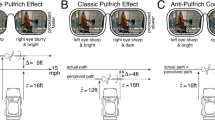Abstract
THE optical aids conventionally used for the improvement of sub-normal vision at near viewing distances (for example, reading) comprise compound, short microscopic systems of varying magnifications, often obtained by placing an additional convex lens over the objective of a Galilean telescopic unit. These microscopic spectacles present a number of disadvantages; thus they have a very restricted field of view (usually less than 30°), they cause changes in spatial perception and, moreover, are heavy, conspicuous, and, in Australia, very costly. Compound systems are employed because of the contention, expressed throughout the literature, that single high-power convex lenses could not provide the necessary field properties.
Similar content being viewed by others
References
Emsley and Swaine, “Ophthalmic Lenses” (Hatton Press, 1946).
Emsley, H. H., Optician, 125, 3243 (1953).
Author information
Authors and Affiliations
Rights and permissions
About this article
Cite this article
LEDERER, J. A New Development in Aids for Sub-normal Vision. Nature 174, 977–978 (1954). https://doi.org/10.1038/174977a0
Issue Date:
DOI: https://doi.org/10.1038/174977a0
- Springer Nature Limited





